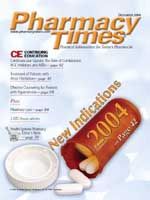Publication
Article
Pharmacy Times
RxPRODUCT NEWS: PROFILE: Cardizem LA (diltiazem hydrochloride)
Author(s):
The treatment of chronic stable anginarecently expanded to include Biovail'sCardizem LA, a long-acting tabletformulation of diltiazem hydrochloride,which received approval from the FDAin April 2004.1
In the United States alone, approximatelyone half of emergency departmentpatients who present withmyocardial infarction have preexistingangina. Each hospitalization extrapolatesto ~30 patients with chronic stableangina. Mortality rates from chronic stableangina remain high: ischemic heartdisease is still the leading cause of deathin the Western world. Its morbidity issignificant, too, resulting in millions ofhospitalizations each year. Its impact onquality of life is equally important;chronic chest pain syndrome impairsdaily activities, sometimes for days at atime. Although cardiovascular mortalityhas been declining overall, the treatmentof chronic stable angina remainsworthy of concern.2
Described by Biovail as a "gradedreleaseformulation" of diltiazemhydrochloride, Cardizem LA is identifiedby the FDA as a distinct dosagedeliverysystem and is not therapeuticallyequivalent to the various otherextended-release diltiazem productson the market.3 Biovail promotesCardizem LA as providing 24-hourantianginal and antihypertensive controland asserts that other diltiazemformulations do not achieve morningpeak-plasma concentrations comparablewith those of Cardizem LA. Althoughevening administration isadvertised to result in peak levels"when patients need it most"—between 6 AM and noon—the manufactureradmits that the clinical significanceof administration time isunknown.4 Cardizem LA was previouslyapproved for the treatment ofhypertension.
Pharmacology
As a calcium channel blockingagent, Cardizem LA exerts its effect byinhibiting the calcium ion influx duringmembrane depolarization in cardiacand smooth muscle. This actionresults in a decrease in heart rate andsystemic blood pressure, which leadsto increased exercise tolerance anddecreased myocardial oxygen demand.Additionally, Cardizem has beenshown to dilate and relax coronaryarteries.5
Clinical Studies
Cardizem LA and its impact on anginawere studied in a randomized, double-blind, parallel-group, dose-responsetrial of 311 patients with chronic angina.Treatment with doses of 180, 360, and420 mg administered in the evening wascompared with the administration of360 mg in the morning and with placebo.Compared with placebo, all 3evening doses increased exercise tolerance21 hours after administration. At25 hours after administration, the morning360-mg dose also was shown toincrease exercise tolerance, although to asmaller extent than the evening doses.5
Contraindications
Cardizem LA is contraindicated inpatients with sick sinus syndrome orwith second- or third-degree atrioventricular(AV) block, unless a functioningventricular pacemaker is present.The drug also is contraindicated inhypotensive patients with a systolicpressure of<90 mm Hg, in patientswith documented acute myocardialinfarction and pulmonary congestion,and in patients with a hypersensitivityto diltiazem.5
Precautions
Cardizem is metabolized hepaticallyand excreted renally. Caution should beused with patients with impaired hepaticor renal function. Prescribers should beadvised that concurrent use of CardizemLA with cimetidine may increase diltiazemlevels. Other potential drug interactionsinclude those with digitalis, anesthetics,benzodiazepines, cyclosporine,carbamazepine, lovastatin, and rifampin.Use with known CYP 3A4 inducersshould be avoided when possible.5
Dosing
Treatment of angina should be initiatedat 180 mg once a day, with doseincreases every 7 to 14 days if needed.Total daily doses should not exceed360 mg.6
Adverse Reactions
In the angina study, side effects weresimilar to those previously reportedfrom diltiazem. They included lowerlimbedema, dizziness, fatigue, bradycardia,first-degree AV block, and cough.5
Dr. Holmberg is a pharmacist with Phoenix Indian Medical Center, Phoenix, Ariz. The opinions expressed are those of the author and not necessarily of any government agency.
For a list of references, send a stamped, self-addressed envelope to: References Department, Attn. A. Stahl, Pharmacy Times, 241 Forsgate Drive, Jamesburg, NJ 08831; or send an e-mail request to: [email protected].

Newsletter
Stay informed on drug updates, treatment guidelines, and pharmacy practice trends—subscribe to Pharmacy Times for weekly clinical insights.






